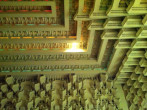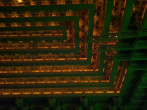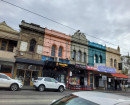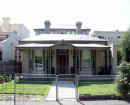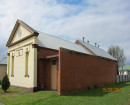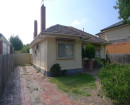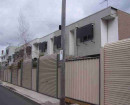CAPITOL HOUSE
109-117 SWANSTON STREET MELBOURNE, MELBOURNE CITY
-
Add to tour
You must log in to do that.
-
Share
-
Shortlist place
You must log in to do that.
- Download report
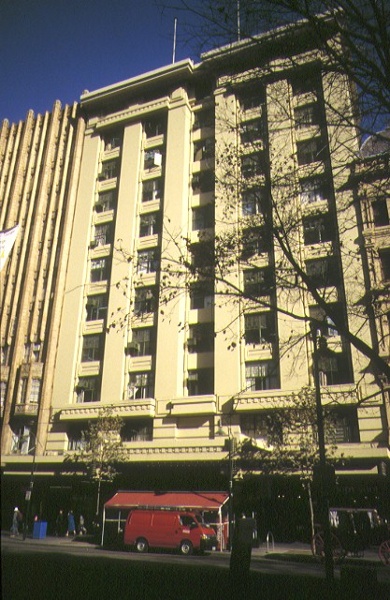

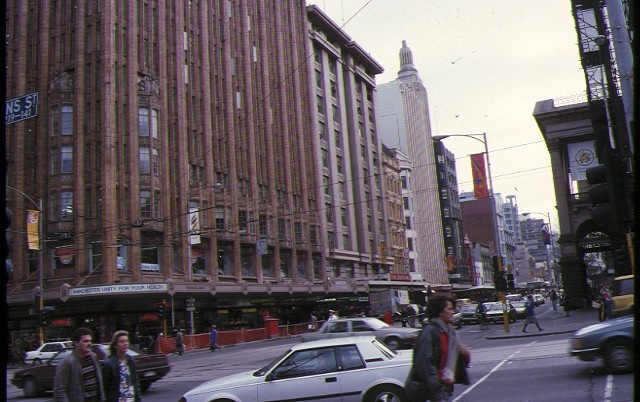
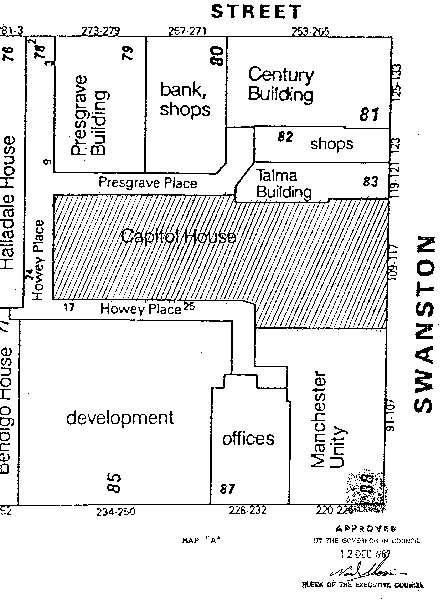
Statement of Significance
What is significant?
Capitol House, Swanston Street was built in 1921-24 to house a theatre and shops and a ten level office tower. It was designed by Walter Burley Griffin and his wife Marion Mahony, in association with Peck and Kemter, and incorporated Melbourne's first picture palace. Threatened with demolition in the 1960s, the building was retained, however it was extensively altered.
In the early 1920s, this block in Swanston Street was at the heart of the city retail trade. In 1921 it was purchased by two companies, headed by Greek community leader, philanthropist and restaurateur; A. J. J. Lucas; American entrepreneur and film expert, Herman E. Phillips, and Raynes Dickson. Lucas was instrumental in securing the services of Walter Burley Griffin who had already undertaken architectural work for him. Brought into the Capitol building company for his film knowledge, Phillips was one of the brothers responsible for Luna Park (1912, VHR H0938) and the Palais Theatre (1927 VHR H0947). Lucas and Phillips visited the United States and England to inspect the latest theatres and to purchase the necessary fittings, including an expensive Wurlitzer organ, one of only four in the world at the time.
The main contracts for the building were let in 1921. Built of steel and reinforced concrete to the maximum permissible height of 132 feet (40.3 metres) by the principal builder, John Monash's Reinforced Concrete and Monier Pipe Construction Company, the building was technically advanced in its construction. The use of reinforced concrete enabled the complete elimination of internal columns to support the dress circle in the auditorium and also allowed construction of a daring cantilevered street verandah.
Capitol House was designed to include more than one hundred offices, six shops, a large auditorium to seat more than two thousand people, and associated lobbies, lounges and staircases. The building was designed to be exposed on all sides, unlike most city buildings at the time. The highly modern Swanston Street facade incorporates vertical piers which extend the entire height of the building, capped by deep cornices and grouped in three to produce two pylon-like motifs. Revivalist themes are eliminated by the lack of detail on this facade.
The Capitol Theatre opened in November 1924, displaying an auditorium designed to create pure fantasy. The main feature is the cave-like crystalline modelled plasterwork ceiling with concealed coloured lights which change systematically through a range of hues and brightness. Foyers were also cave-like with stepped, illuminated ceilings, decorated columns and interpenetrating voids.
Paramount Pictures leased the Capitol Theatre until Hoyts took over the lease in 1940. The early 1960s saw the demise of a number of Melbourne's large cinemas and in 1963 Hoyts did not renew their lease on the Capitol Theatre. This resulted in proposals for demolition, or alteration, of the building and instigated a campaign for its rescue. A compromise resulted in the retention of the auditorium ceiling, but the destruction of the ground level foyer and stalls, due to the insertion of a new floor within the original auditorium. The main elements of the theatre, including the upper foyers and the front facade, remain substantially intact.
How is it significant?
Capitol House, Melbourne is of architectural, historical, aesthetic and scientific (technical) significance to the State of Victoria.
Why is it significant?
Capitol House, Melbourne is of architectural significance as a unique expression and highly advanced design concept by the creative and well known architects, Walter Burley Griffin and Marion Mahony. It is of significance as one of their greatest works and as their largest commercial building project.
Capitol House, Melbourne is of architectural significance for its highly original combination of offices, shops and an entertainment venue in one building. Although not unique, it was an advanced concept at the time, developed on a major scale with the inclusion of a vast auditorium.
Capitol House, Melbourne is of historical significance as the first of three great picture palaces built in Melbourne in the 1920s. Predating the Regent Theatre (VHR H0690) and the Forum Theatre (former State Theatre VHR H0438) by five years, it exposed Melburnians to a totally new phenomenon that was to become a fundamental part of popular culture.Capitol House, Melbourne is of historical significance as the focus of one of Melbourne's first conservation campaigns. This included support from the National Trust, the Royal Victorian Institute of Architects and architectural writer, Robin Boyd.
Capitol House, Melbourne is of aesthetic significance for its foyers and auditorium interiors, which are extraordinary and were highly advanced in concept in the 1920s. The auditorium ceiling design, with its spectacular lighting effects, is of particular importance.
Capitol House, Melbourne is of scientific (technical) significance for its highly innovative structural design which explored the limits of steel and concrete.
[Online Data Upgrade Project 2008]
-
-
CAPITOL HOUSE - History
Capitol House, Swanston Street was built in 1921-24 to house a theatre and shops and a ten level office tower. It was designed by Walter Burley Griffin and his wife Marion Mahony, in association with Peck and Kemter, and incorporated Melbourne's first picture palace. Threatened with demolition in the 1960s, the building was retained, however it was extensively altered.
In the early 1920s, this block in Swanston Street was at the heart of the city retail trade. In 1921 it was purchased by two companies, headed by Greek community leader, philanthropist and restaurateur; A. J. J. Lucas; American entrepreneur and film expert, Herman E. Phillips, and Raynes Dickson. Lucas was instrumental in securing the services of Walter Burley Griffin who had already undertaken architectural work for him. Brought into the Capitol building company for his film knowledge, Phillips was one of the brothers responsible for Luna Park (1912, VHR H0938) and the Palais Theatre (1927 VHR H0947). Lucas and Phillips visited the United States and England to inspect the latest theatres and to purchase the necessary fittings, including an expensive Wurlitzer organ, one of only four in the world at the time.
Paramount Pictures leased the Capitol Theatre until Hoyts took over the lease in 1940. The early 1960s saw the demise of a number of Melbourne's large cinemas and in 1963 Hoyts did not renew their lease on the Capitol Theatre. This resulted in proposals for demolition, or alteration, of the building and instigated a campaign for its rescue. A compromise resulted in the retention of the auditorium ceiling, but the destruction of the ground level foyer and stalls, due to the insertion of a new floor within the original auditorium. The main elements of the theatre, including the upper foyers and the front facade, remain substantially intact.
The draft statement of significance and the above history were produced as part of an Online Data Upgrade Project 2008. Sources were as follows:
Allom Lovell and Associates Pty Ltd. The Capitol Building Conservation Study. Melbourne 1989
Herald. Capitol Theatre Supplement. 7 November 1924, p 8
R. Thorne. Cinemas of Australia via U. S. A. Sydney 1981
T. Walters. The Picture Palaces of Melbourne. Melbourne 2003CAPITOL HOUSE - Plaque Citation
Designed by Walter Burley Griffin and Marion Mahony and opened in 1924, this building contained a vast auditorium which was Melbourne's first picture palace. Its spectacular illuminated, modelled ceiling survived extensive alterations in the 1960s.
CAPITOL HOUSE - Permit Exemptions
General Exemptions:General exemptions apply to all places and objects included in the Victorian Heritage Register (VHR). General exemptions have been designed to allow everyday activities, maintenance and changes to your property, which don’t harm its cultural heritage significance, to proceed without the need to obtain approvals under the Heritage Act 2017.Places of worship: In some circumstances, you can alter a place of worship to accommodate religious practices without a permit, but you must notify the Executive Director of Heritage Victoria before you start the works or activities at least 20 business days before the works or activities are to commence.Subdivision/consolidation: Permit exemptions exist for some subdivisions and consolidations. If the subdivision or consolidation is in accordance with a planning permit granted under Part 4 of the Planning and Environment Act 1987 and the application for the planning permit was referred to the Executive Director of Heritage Victoria as a determining referral authority, a permit is not required.Specific exemptions may also apply to your registered place or object. If applicable, these are listed below. Specific exemptions are tailored to the conservation and management needs of an individual registered place or object and set out works and activities that are exempt from the requirements of a permit. Specific exemptions prevail if they conflict with general exemptions. Find out more about heritage permit exemptions here.Specific Exemptions:General Conditions: 1. All exempted alterations are to be planned and carried out in a manner which prevents damage to the fabric of the registered place or object. General Conditions: 2. Should it become apparent during further inspection or the carrying out of works that original or previously hidden or inaccessible details of the place or object are revealed which relate to the significance of the place or object, then the exemption covering such works shall cease and Heritage Victoria shall be notified as soon as possible. Note: All archaeological places have the potential to contain significant sub-surface artefacts and other remains. In most cases it will be necessary to obtain approval from the Executive Director, Heritage Victoria before the undertaking any works that have a significant sub-surface component.General Conditions: 3. If there is a conservation policy and planall works shall be in accordance with it. Note:A Conservation Management Plan or a Heritage Action Plan provides guidance for the management of the heritage values associated with the site. It may not be necessary to obtain a heritage permit for certain works specified in the management plan.
General Conditions: 4. Nothing in this determination prevents the Executive Director from amending or rescinding all or any of the permit exemptions. General Conditions: 5. Nothing in this determination exempts owners or their agents from the responsibility to seek relevant planning or building permits from the responsible authorities where applicable. Minor Works : Note: Any Minor Works that in the opinion of the Executive Director will not adversely affect the heritage significance of the place may be exempt from the permit requirements of the Heritage Act. A person proposing to undertake minor works must submit a proposal to the Executive Director. If the Executive Director is satisfied that the proposed works will not adversely affect the heritage values of the site, the applicant may be exempted from the requirement to obtain a heritage permit. If an applicant is uncertain whether a heritage permit is required, it is recommended that the permits co-ordinator be contacted.
-
-
-
-
-
TRADES HALL
 Victorian Heritage Register H0663
Victorian Heritage Register H0663 -
ST PETERS EASTERN HILL PRECINCT
 Victorian Heritage Register H0009
Victorian Heritage Register H0009 -
ICI HOUSE
 Victorian Heritage Register H0786
Victorian Heritage Register H0786
-
10 Down Street
 Yarra City
Yarra City
-






